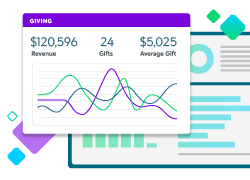4 Reasons to Start Planning Ahead for Giving Tuesday

Whether you’re brand new to nonprofit work or a veteran of the sector, you know that Giving Tuesday is one of the most important fundraising days of the year.
This is because Giving Tuesday gets nonprofits real results. Giving Tuesday began in 2012, raising an estimated $10 million in its first year, according to Nonprofits Source. But the movement’s momentum hasn’t slowed since then. CBS News reported that in November 2022, Giving Tuesday raised an incredible $3.1 billion for charitable causes.
Because of Giving Tuesday’s major fundraising potential, it’s never too early to start planning your campaign. Giving Tuesday takes place the Tuesday after the U.S. Thanksgiving holiday each year, meaning that nonprofits have almost an entire year to analyze their data from this past Giving Tuesday and start planning for 2023.
Of course, as one of your most important annual fundraisers, it can be challenging to know where to begin when it comes to planning a Giving Tuesday campaign. To help you get started, this article will explore four ways you can plan ahead now, including:
- Create a research-based fundraising strategy.
- Start testing your outreach plans.
- Get a head start on prospect research.
- Spend time strengthening donor relationships.
Keep in mind that your Giving Tuesday strategy shouldn’t only focus on the day itself. Throughout the year, conduct preparation, strategy development, and stewardship efforts to make your audience eager to give when the big day arrives. When you put in the work ahead of time, you will have solid strategies already in place and ready to go.
1. Create a research-based fundraising strategy.
When you start Giving Tuesday planning early, you can devote time to crafting a data-driven, evidence-based fundraising strategy based on previous campaigns.
Start your planning process by reviewing your fundraising strategy for this past Giving Tuesday and its overall performance. Donorly’s fundraising strategy guide recommends looking at these key aspects when analyzing past campaigns:
- Most and least successful marketing and appeal tactics
- Key fundraising metrics like donor retention rate, donation frequency, and fundraising return on investment (ROI)
- The level of supporter engagement with each of your marketing platforms
- Your donor base’s demographics
These metrics provide a comprehensive overview of your organization’s fundraising and outreach efforts that you can use to craft a new strategy.
For example, if you discover your donor retention rate is falling, you can focus on donor stewardship in the months leading up to Giving Tuesday to boost retention. Or, you may notice your donor base is trending toward a certain demographic, such as younger donors. Then, for your next campaign you might update your marketing materials and messaging strategy to align with younger donors’ interests and engage with them on the platforms they frequent.
2. Start testing your outreach plans.
Before they can contribute to your campaign, donors need to know it exists. By planning your Giving Tuesday campaign early, your team will have greater flexibility and increased preparation time to enact a marketing strategy that will reach as many donors as possible.
To expand your audience, consider how you can take a multi-channel marketing approach. Explore advertising opportunities such as:
- Your email newsletter. You likely send a weekly or monthly newsletter to update supporters on your current projects, fundraising progress, and any upcoming events. Be sure to send Giving Tuesday-related updates and reminders starting a month or two in advance. Highlight different aspects of the campaign in each email to keep donors engaged and create a sense of momentum. For example, talk about how past Giving Tuesday support has had an impact on the programs and services you offer to your community, and what initiatives the upcoming Giving Tuesday will support. You should also share the fundraising goal you’re trying to reach. This way, you’ll inspire your supporters to participate in your campaign.
- Your social media pages. Create informational posts about your campaign and what money raised on Giving Tuesday will support, and be sure to make them shareable so current supporters can repost them to their accounts and reach an even larger audience. Also, use this time to look into platform-specific fundraising opportunities, such as Facebook fundraising. Test run Facebook fundraising for other campaigns and create a guide of fundraising best practices your volunteer fundraisers can use.
- Your website. Your website is the online hub that supporters use to learn more about your mission and get involved through donating or volunteering. Create a page on your website that explains what Giving Tuesday is and encourages your website visitors to watch for announcements about your upcoming Giving Tuesday campaign. You should also take the time to fine-tune your donation page so that on the big day, it’s easy for your supporters to give. On Giving Tuesday, use engaging visuals like a fundraising thermometer or donor leaderboard throughout your website to get supporters excited about helping you reach your campaign goals.
Be sure to also develop your branding strategy for your Giving Tuesday campaign. Will you have a specific hashtag for supporters to use or a tagline for all of your email campaigns? Figure out these details early on so you can finalize your style guide and roll it out across your team well ahead of Giving Tuesday.
3. Get a head start on prospect research.
The months leading up to Giving Tuesday present a great opportunity to improve your approach to prospect research. Prospect research is the process of analyzing your donor database and other tools to identify potential major donors, allowing nonprofits to focus on strong leads to secure major gifts, capital campaign contributions, and planned gifts.
Giving Tuesday campaigns typically focus on securing many smaller individual donations rather than major gifts, but prospect research can still provide insights that you can apply to your overall supporter base. You won’t need to conduct intensive prospect research for every donor you expect to contribute on Giving Tuesday, but the information you gather can be useful for building relationships later.
As with all fundraising campaigns, data should be at the forefront of your prospect research strategy. Use your prospecting tools to identify donors with characteristics such as:
- Strong existing relationship with your nonprofit. Donors who’ve contributed to your cause or interacted with your organization recently have demonstrated their connection to your nonprofit and are likely to give again.
- History of donating or volunteering with similar organizations. These markers indicate a person’s affinity for your cause, making them likely to be receptive to opportunities to increase their impact.
- Political contributions. This can signify a prospect’s capacity to give—if they give to a political cause they care about, they may have funds to give to a charitable cause, as well.
- Professional or personal connections. Certain prospects may have work-related or familial connections with other individuals in your database. This can help you refine your communications and identify corporate matching gift opportunities.
- Demographic and personal information. Information such as age, location, and marital status can help you personalize your communications.
- Wealth indicators. Markers such as real estate holdings or stock ownership can help signify a prospect’s capacity and ability to give to your organization.
There are many ways to use the insights you gather from prospect research. For example, you might use this information to identify a board member, major donor, or foundation that could provide a day-of challenge or matching grant on Giving Tuesday.
Say you ask a board member to match donations on Giving Tuesday up to $5,000. With this kind of arrangement in place, you’ll encourage your supporters to give so that they can take full advantage of the amount being offered. By conducting prospect research with this purpose in mind, you can have this arrangement set up in the early fall, well before Giving Tuesday arrives.
You can also use prospect research insights to craft your broader Giving Tuesday strategy. Demographic data, historical giving, and engagement metrics can help you decide how to segment your audience and construct your marketing strategy.
For example, if you’ve noticed that a large number of your supporters are people who live in a certain geographic area, you can create a targeted direct mail campaign that appeals to their communication preferences. Or, if you have a dedicated group of regular volunteers, you can create a segment and reach out to them ahead of Giving Tuesday about opportunities to get involved, beyond donating.
4. Spend time strengthening donor relationships.
While your nonprofit should strive to take a one-on-one approach when cultivating relationships with major donors, you can strengthen relationships with all of your supporters by individualizing communication as much as possible.
By personalizing your messages, you’ll treat supporters as individuals and ensure they receive messages that are interesting and relevant to them, specifically. This approach will help you retain more donors, allowing you to spend less time and funds soliciting new donors throughout the year and focus instead on planning an incredible Giving Tuesday campaign.
To get started with your donor stewardship efforts, demonstrate your gratitude and commitment to supporters by:
- Meeting them where they are. Actively build a community by connecting with supporters through their preferred communication channels.
- Creating experiences that fulfill their needs. Listen to your supporters’ needs by sending surveys and polls where they can provide feedback. Thank supporters for taking the time to complete your survey, and analyze responses to find trends in feedback. While you may not be able to implement everything your supporters share, implementing what you can shows you value their opinions and can improve your campaign.
- Frequently expressing appreciation. Demonstrate gratitude by not only sending thank-you notes, but also showing supporters how their contributions make a difference with stories and statistics.
While you should focus more personalized attention on your prospective major donors, with activities such as one-on-one phone calls and personal event invitations, the broader concepts of stewardship should apply across the board to all supporters. This will help you create a sustainable community of dedicated supporters ahead of Giving Tuesday. Plus, it will boost retention after the year-end season comes to a close.
Ultimately, there’s no reason to put off your Giving Tuesday planning. The sooner you get started, the better you can strategize around strengthening your support network and spreading the word about your campaign. Giving Tuesday quickly sneaks up on nonprofit professionals each year, but with an effective plan in place, you can make the most of this amazing annual opportunity. Blackbaud offers a free GivingTuesday planning guide with email and social media templates.
The Nonprofit CRM Built for Fundraisers
Find out how Blackbaud’s Raiser’s Edge NXT® fits your organization.



